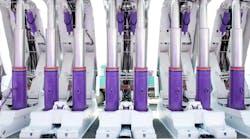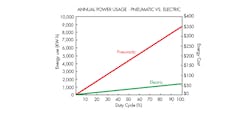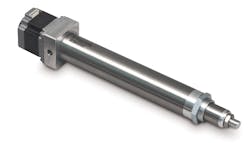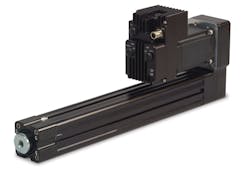Download this article in PDF format.
Moving a load in a straight line can be done using a variety of linear actuator devices employing both rod and rodless technologies. For rod-style actuation requiring lower amounts of force requirements (less than 1,000 lb), there have traditionally been two possible approaches: pneumatic actuators (typically called cylinders) and electric actuators.
Relatively recently, some manufacturers have been combining the control, drive and amplifier, motor, coupling, and other components into the actuator, giving designers a third choice—another type of electric rod-style device called an integrated actuator.
For many years, pneumatic rod-style cylinders have been widely used based on their cost-effectiveness and simplicity to install and use. However, electric rod-style actuators, both traditional and integrated, have designers who advocate for them based on their flexibility and “sustainability,” i.e., supporting the growing trend toward energy conservation and environmental compatibility. Despite these advantages, electric rod-style actuators have been perceived as a more expensive and complex solution for linear-motion applications.
Here’s look at the advantages and disadvantages of rod-style pneumatic cylinders, electric actuators, and integrated electric actuators in motion-control applications. We’ll explore the effectiveness of each technology in reducing purchasing, operating and installation costs, machine footprints, and number of components—all key issues in motion control and automation today.
Pneumatic Cylinders
A pneumatic motion-control system is made up of many ancillary components besides the cylinder. This includes a source of compressed air that uses:
• An air compressor that generates pressure.
• Condensers (dryers) to regulate the compressed air’s humidity.
• Air lines (pipe/tubing) that distribute compressed air throughout a plant.
• Drop lines (access points) to route compressed air from the plant’s air line to individual work locations.
Each access point typically uses an FRL (Filter–Regulator–Lubricator) to filter the air, regulate the air pressure, and lubricate the actuators at the point of work to help prolong actuator performance. An FRL may supply a single pneumatic cylinder or a bank of several pneumatic cylinders.
Each cylinder then needs a solenoid-operated air valve (typically two- or three-position depending on application) and connecting air lines to the pneumatic cylinder. A logic device (with wiring) to operate the solenoid is also needed. The solenoid-operated air valve has different flow paths, depending on the position selected, that directs air flow to a pneumatic cylinder, letting it extend and retract.
This is a typical pneumatic cylinder with ports for compressed air to power the linear motion.
Pneumatic cylinders have a long history of being popular workhorses in the automation industry. Their simple design makes them a low-cost choice in the rod-style actuator category.
Another major advantage is their low unit-level price points, which have been a significant barrier to implementing advanced electric technologies. Pneumatic cylinders are also easily controlled via simple digital I/O signals that do not call for in-depth knowledge of motion-control components for operators. Some pneumatic setups have distributed solenoid banks that receive signals over networks such as Ethernet. Pneumatic cylinders have good service lives, as units can be rebuilt easily and economically. In addition, industry standards for cylinder sizes, mounting, and interface details make them easily interchangeable.
Current trends toward sustainable manufacturing (i.e., trying to be more environmentally friendly) have led companies to look closer at the energy inefficiencies of pneumatic cylinders. Compared to their electric counterparts, pneumatic cylinders are neither environmentally friendly nor energy-efficient due to the energy losses during compression, distribution, and use. The distribution infrastructure almost invariably leaks, and even little leaks can waste a lot of money and lower manufacturing efficiency.
For example, cumulative leaks, which may be in a number of places (e.g., fittings, cylinders, and valves), add up. If all of the leaks added up to the equivalent of a 0.25-inch hole, and the system operated 24/7 at $0.04 per kW-h, the hole would waste $6,600 per year in energy. The dollar amounts can rapidly multiply for large manufacturing operations.
Besides leaks, compressed-air systems operate at about 10% efficiency while their electric counterparts operate at 75% to 80% efficiencies. So a pneumatic cylinder uses much more energy (electricity) than an electric actuator, and the higher the application’s duty cycle, the more the gap widens in the electric actuator’s favor.
Since most electricity is still generated by burning fossil fuels (primarily coal), efficiency directly correlates to how much CO2 emissions are needed to support manufacturing operation. Given recent international agreements, reducing CO2 emissions has become public policy.
Another major disadvantage of pneumatic cylinders is their limited flexibility in performance and capability. For example, it is difficult to regulate velocity, do mid-stroke positioning, and program multiple positions with pneumatic cylinders. A simple pneumatic cylinder would need to increase exponentially in complexity to meet these challenges. That’s why applications requiring precise position control, velocity control, and/or multiple positioning tend to favor electric actuators. In addition, pneumatic cylinders are noisy, thanks to the compression and release of air on each stroke.
Traditional Electric Actuators
Traditional electric actuators also require a host of other devices to operate, but do not require as involved an infrastructure as pneumatic cylinders. Although the power source is simply line voltage, electric actuators also need a digital drive, motor, coupler, motor mount, actuator, cables, and an enclosure or electrical cabinet. Some electric actuators may also need a motion controller or PLC.
A traditional electric rod actuator, such as this Tolomatic ERD version, includes an actuator mounted to a motor. In this case, the motor is a stepper motor.
Electric actuators have been around for years and are becoming more popular as the automation industry looks for more precise and complex motion with more efficient components. Electric actuators are typically fully programmable and provide maximum application flexibility. This flexibility lets them tightly coordinate the motion of several actuators for more complex applications. As stated earlier, electric actuators typically operate within the 50% to 70% efficiency, cost less to operate than pneumatic cylinders, and are more “green” or environmentally friendly.
The major disadvantage of electric actuators (actuator, motor mount, coupler, motor and drive) is that they require higher initial investments. The price of necessary components can be from three to 10 times more than those for a pneumatic axis of motion (cylinder, solenoid/valve, and air lines), and at least two times more than an integrated electric actuator (actuator, power supply). However, the total lifetime cost of electric actuators can be less than a pneumatic cylinder. In addition, there are assembly and installation costs.
Installing traditional electric actuators also requires cabling and/or wiring to and from the drive(s) in the cabinetry, increasing the overall cost and system footprint. Pneumatic and integrated electric actuators typically do not require additional cabinet space.
Integrated Electric Actuators
Before the introduction of integrated electric actuators, engineers looking for more functionality than that of a pneumatic cylinder had one choice: a traditional electric actuator. An integrated electric actuator typically includes the motion controller, drive or amplifier, motor, coupling, motor mount, and actuator in a compact package. As such, it provides an all-in-one solution with reduced costs and more efficient operation.
Integrated electric rod actuators typically include a servo motor and encoder combined with the actuator, just like this Tolomatic RSA actuator and ASCI servo-motor drive/controller are packaged as one unit.
Integrated electric actuators combine the advantages of both pneumatic (simplicity, low cost) and traditional electric actuators (flexibility, energy efficiency). Integrated electric actuators are typically less expensive than a traditional electric actuator, which reduces the cost objections associated with switching from pneumatic to electric technology.
Integrated actuators typically operate in a standalone mode with the addition of a 24- to 48-Vdc power supply. Most motion-control systems already have this voltage range available for other logic devices, such as sensors, switches, and digital I/Os. Depending on the configuration of the integrated actuator and how it is used, the cabling requirements are limited to the power supply, discrete I/O lines, or communications. This significantly reduces the assembly costs associated with running cable throughout the equipment and wire-ways in the cabinet.
Although integrated actuators are less complicated than the infrastructure needed for traditional electric actuators, they do depend on a separate power supply for operation, a potential disadvantage. If existing power supplies do not meet the necessary power requirements, they must be upgraded or additional power supplies must be added.
Although integrated actuators are suitable for a wide range of high-duty-cycle industrial applications, they do have performance limitations with respect to speed and force. This is due to the compact nature of the all-in-one package. The integrated power components contained within the actuator (motor, drive, and controller) all generate heat, which limits the actuator’s maximum speed and force capabilities. Higher force and speed applications still require traditional electric actuator and pneumatic cylinder.
Today’s integrated electric actuators are suitable for a wide range of low- to mid-force, industrial motion-control applications that require flexibility, efficiency, and a compact footprint.
Pneumatic cylinders, traditional electric actuators, and integrated electric actuators all have their place in today’s industrial market. Pneumatic cylinders will be widely used as a result of low component costs and the availability of compressed air in existing facilities. But many engineers are beginning to evaluate the overall inefficiencies and costs of pneumatic systems, and have begun the move toward deploying electric motion actuators, including integrated versions.
The market for traditional electric actuator solutions will also grow as motion-control applications become more complex and the conversion from air to electric accelerates. Integrated actuators are a newer actuator category that delivers significant advantages over both pneumatic and traditional electric actuators. Integrated actuators will save customers energy and move them closer to sustainable manufacturing than pneumatic cylinders. On top of that, they save users purchase, installation, and assembly costs, while reducing the overall footprint of the machine compared to traditional electric actuators.
Aaron Dietrich is Product Manager for Tolomatic Inc.





